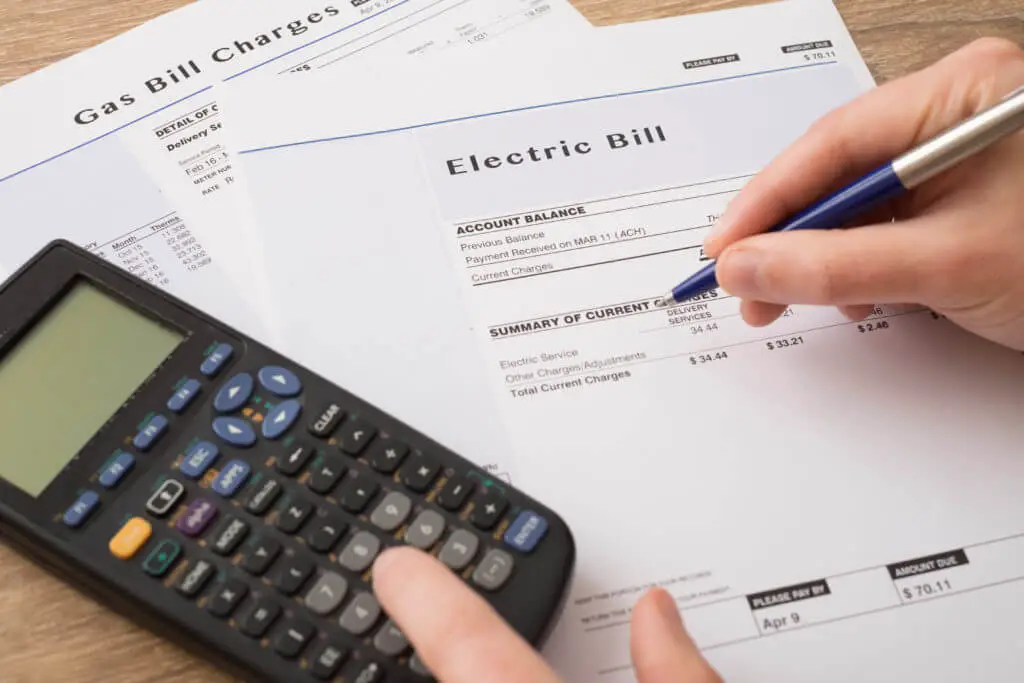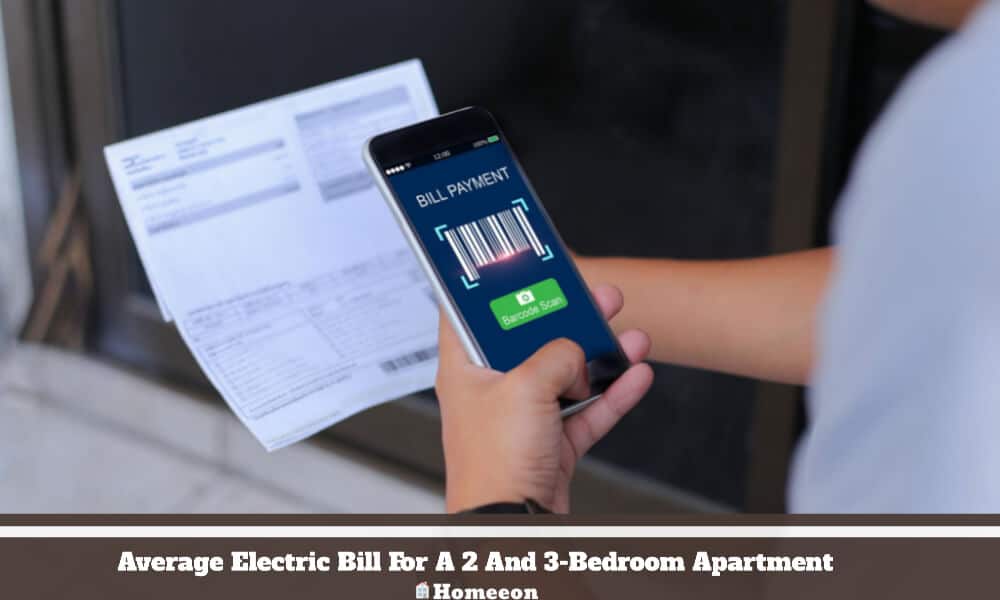Last Updated on July 27, 2023 By Emma W. Thomas
The average electric bill for a 2-bedroom apartment in the United States ranges from $70 to $100 per month, while for a 3-bedroom apartment, it typically ranges from $100 to $150 per month. Actual costs may vary based on location, energy usage, and local utility rates.
Average electricity bills by state in the USA (2 And 3-Bedroom Apartment)
| State | Average Electricity Bill for 2-Bedroom Apartment (per month) | Average Electricity Bill for 3-Bedroom Apartment (per month) |
|---|---|---|
| Alabama | $100 – $150 | $130 – $190 |
| California | $80 – $140 | $100 – $180 |
| Florida | $100 – $160 | $130 – $200 |
| New York | $80 – $130 | $100 – $160 |
| Texas | $90 – $150 | $120 – $180 |
| Illinois | $80 – $130 | $100 – $160 |
| Ohio | $80 – $130 | $100 – $160 |
| Pennsylvania | $90 – $140 | $120 – $180 |
| Georgia | $100 – $160 | $130 – $200 |
| Arizona | $90 – $150 | $120 – $180 |
How Do Electric Bills Compare Between New York And Other Towns?

Electric bills are highly affected by the state you live in and have a huge impact on how they add up. In some states like Hawaii, it is difficult to save up on electricity costs, but it is not impossible. Every state has different laws that govern energy costs, pricing, and purchase options. Below is a list of the top five states with the highest electric energy rates.
Hawaii
Hawaii has always been the topmost state with the most expensive electric energy rates. Ironically, it is also on the top five list with the lowest overall energy consumption due to its mild and tropical nature. Electric energy is expensive since Hawaii highly depends on petroleum as its main source of electricity which is very expensive despite having a geothermal capacity. In recent times, Hawaii has started shifting to a more reliable and renewable energy source: solar energy.
Alaska
Alaska has its electricity energy rates at 17.58 cents per kWh which is very high. Just like Hawaii, Alaska also depends on petroleum as its main source of electric energy. It is the only state that has successfully harnessed geothermal power to create a renewable energy source. The electric bill of most Alaskans is still high since they still primarily rely on diesel-powered generators for domestic use.
Connecticut
Electricity in this state is the most expensive in the northeast. Almost half of its electricity comes from the Milestone Nuclear. Only about 3.5% of electrical energy for Connecticut is from renewable sources, making their rates remain as high as 16.98 per kWh.
New York
New York is among the states that produced the highest hydroelectric power in the Rocky Mountains, established by Robert Moses Niagara. His power plant was able to produce over 2500 megawatts within the state. New York plans to install over 3,000 megawatts of solar photovoltaic facilities, which will greatly cost the individuals living in the state. Currently, New York’s electricity rates stand at 16.25 cents per kWh which is a bit higher for a normal working person.
Washington
Washington is the state with the lowest average energy prices, which range at 7.15 cents per kWh. It is also the country’s leading producer of hydroelectric energy. Thanks to the Gran Coulee Dam, Washington has the largest power plant, which generates 6,809 megawatts of electric power.
What Factors Affect The Cost Of Electricity Bills In A Household?
It may seem illogical to find out that electricity rates differ from one state to another. A lot of processes take place before you get to flip on the switch in your house. Electric energy must be generated and delivered to your home using equipment that requires maintenance and runs on fuel. Changes in prices at any point of electric production will also affect your electric bill rates. Some of the factors that affect the average cost of electric bills in your home include;
Fuel Costs
Processes involved in electric power generation and delivery to the point of consumption require fuel. Since fuel prices vary now and then, it affects the electricity cost. When fuel prices go high, so will your electricity bills and vice versa.
Power Plants Costs
Like any other business facility, power plants also need to be built and maintained. Maintaining a power plant comes in with other associated costs such as operating and maintenance costs. A large power plant will require more laborers to run and maintain it, but it will also translate to more power being produced. Less power plant costs translate to less electric bill charges.
Distribution Costs
Transmission and distribution systems need to be built, maintained, and installed in the user’s home. Some distribution systems tend to be more expensive than others which translates to higher electric bills. Sometimes the distribution systems get damaged, and their repairing costs cannot be paid directly by the electric power consumers. They are indirectly included in your electricity bills which are in most cases seasonal as it only applies when there are repairs to be done.
Weather
Weather conditions can do either work for or against you when it comes to electric bill charges. Rain and snow seasons can work in your favor since hydroelectric power generation is high. Windy seasons also help lower the bills since the wind turbines are continuously spinning and generating electricity. However, some extreme weather conditions might demand more electricity, such as high-temperature seasons, which require a continuous cooling system, making it more expensive.
Location And Regulations
Judging from the above factors, it should not be surprising that electric prices depend on where you live. Factors like power plant availability and fuel costs vary from one state to another. A state with several power plants is likely to have lower electric energy rates, unlike one that is highly dependent on non-renewable sources of energy such as petroleum. Electricity bill charges in Washington are incomparable with those in Hawaii due to their power sources.
Washington has a large power plant, whereas Hawaii heavily relies on petroleum sources. Additionally, some states fully regulate public utilities such as electricity while others have unregulated prices such as generators energy. Such states only regulate transmission and distribution energy prices.
Type Of Consumer
Surprisingly, the higher the amount of energy consumed per hour, the less the charges. Commercial and residential users tend to pay more than industrial customers. Industrial customers use large amounts of energy at once, making its generation and supply faster and cheaper. On the other hand, delivering power to households who use less power requires more effort, time, and money. Electric energy rates are also compared to buying items in bulk from a wholesale price versus retailing at a higher price.
What Causes Very High Electric Bills In An Apartment?
Some people dread receiving their electricity bills as they are always high. Some people tend to blame their power sources for hiking rates, while most likely because of their energy consumption. Below are a few factors that cause high household power consumption;
Leaving High Energy Consuming Appliances Plugged In
One of the major reasons that cause high electric bills is leaving appliances that consume a lot of energy plugged in even when not in use. Years ago, there were no such issues, but appliances never power down even by pressing the power off button with modern technology. For instance, when you press the power button of a DVR, computer, or television, they transit to standby mode and still consume energy. When this happens to high energy-consuming appliances such as washing machines, they suck up electricity while waiting for a scheduled activity.
Misusing Light Energy Bulbs And Ceiling Fans
Most people use light to affect the brightness of the entire room, which contributes to high electric bills. Instead, it would help if you used lighting efficiently, such as providing light to specific room areas such as working spaces and kitchen tables. Full-room lights are less effective than lamps which serve perfectly for the light you need for specific room locations. You should switch off the fan if nobody is in the room or use a toggle switch to turn it in the desired direction for optimal use instead of affecting the whole room.
Unnecessary Device Charging
When you look around your home, almost all technology uses electric charges: mobile phones, tablets, PCs, electric toothbrushes and razors, MP3 players, laptops, and a whole lot of other devices. A high-tech and gadget-oriented person translates to high electric bills. If you leave all these gadgets plugged in, they end up sucking up power, and you will likely pay very high electric bills for them.
Instead of directly plugging them in the sockets, you should unplug the AC adapters and chargers when the devices are not in use. Unnecessary charging not only raises your electric bill but also shortens your gadget’s battery life.
Why Is There A Difference In The Average Electric Bill In A 3 And 2-Bedroom Apartment?

With all factors affecting electric energy cost held constant, there is a huge difference in power consumption between different household sizes. For one, a bigger apartment translates to more people living within a home hence more energy consumption. Maintaining a three-bedroom apartment from coolers and heaters is likely to be higher due to the one-bedroom added. The difference in energy consumption also changes depending on the number of appliances in a home. A 3-bedroom apartment is likely to have more appliances than a 2-bedroom apartment which translates to higher electricity bills.
What uses the most electricity in an apartment?
In an apartment, several appliances and devices can contribute to high electricity usage. Here are some of the main electricity-consuming items:
- Heating and Cooling Systems: HVAC systems, such as air conditioners and electric heaters, consume significant electricity, especially in extreme weather conditions.
- Water Heater: Heating water for showers, laundry, and dishes can be a major electricity consumer.
- Refrigerator: Refrigerators run constantly and can be one of the biggest electricity consumers in an apartment.
- Clothes Dryer: Electric dryers consume substantial energy during laundry cycles.
- Lighting: The number of light fixtures and the use of energy-efficient bulbs impact electricity usage.
- Cooking Appliances: Ovens, stoves, and microwaves contribute to electricity consumption during meal preparation.
- Electronics and Gadgets: TVs, computers, gaming consoles, and chargers left plugged in can collectively consume significant energy.
- Air Purifiers and Fans: Continuous operation of these devices can add to electricity usage.
- Dishwasher: Frequent use of electric dishwashers can contribute to higher electricity bills.
- Small Appliances: Devices like coffee makers, toasters, and blenders, when used frequently, can also add to electricity consumption.
Conclusion
Electricity power rates vary from state to state. Hawaii has, for many years, been the topmost state with the highest electricity rates, whereas Washington has the least. These rates are highly affected by what a state relies on as its source of energy. Washington relies on hydroelectric energy, whereas Hawaii relies on very expensive petroleum.
References:
https://www.inspirecleanenergy.com/blog/sustainable-living/average-apartment-electric-bill
https://www.ecoenergygeek.com/average-electricity-bill-3-bedroom-house/
Emma is a graduate of Domestic Science or Family and Consumer Sciences (Home Economics) from the University of Wisconsin. She has 7 years of experience Working with the strategic section of BestBuy and now writing full-time for Homeeon.
From Managing the Home, Interiors, Cleaning, and Exteriors to Gardening and everything about Making A Home Liveable – is her passion and this Homeeon is the result of this.
Emma loves decorating her home with the best stuff found online. She cares about quality over anything and writes reviews about them here in Homeeon. Get in touch with her over Pinterest.
Keep reading her blogs.

